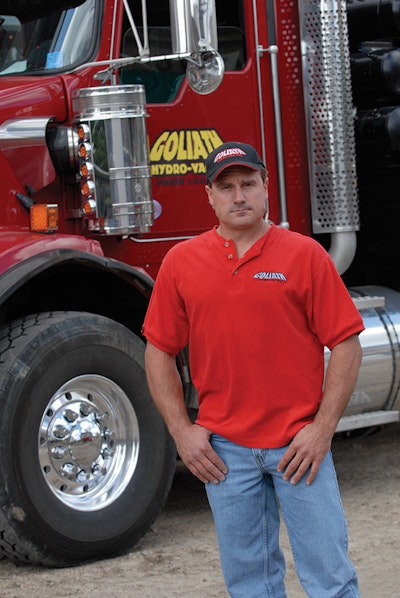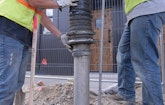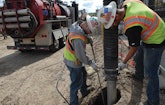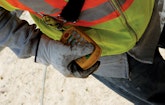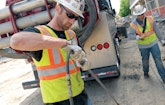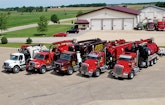Interested in Industrial?
Get Industrial articles, news and videos right in your inbox! Sign up now.
Industrial + Get AlertsWhile he was working for a demolition, construction and excavation company, Brandt Volk saw a need, and he saw little competition. Years later that's still the case. Only one other company in the Twin Cities of Minneapolis-St. Paul performs hydroexcavation.
Goliath Hydro-Vac Inc., the business that Volk started a decade ago with his wife and co-owner, Rachelle, sends crews primarily into five states in the Midwest and Great Plains, but their trucks have ranged even farther on occasion.
Power companies and other customers are calling on him more and more. That's because excavation using high-pressure water and vacuum creates a precisely shaped hole or trench to reach utility lines or pipes efficiently, and without disturbing nearby structures, Volk says. Often, hydroexcavation is now required for work around electric power substations, he says. Anywhere there is a risk from digging with mechanical equipment, hydroexcavation can be an answer.
It's not a cheap startup service specialty. Trucks start at about $350,000 new. Even used trucks cost between $140,000 and $200,000 depending on options. It was hard to get his start, Volk says. Aside from the down payment on the truck, the finance company wanted another $30,000 on hand for working capital.
"When I started, I refinanced my house, and I sold my Harley-Davidson. I sold any-thing worth more than a couple hundred dollars because I was scrambling to come up with that much money up front," he says.
BIG PIECE OF REVENUE PIE
But the investment paid off. Goliath is bigger and working hard. It has nine employees, and Rachelle Volk has two part-time office assistants to help with the paperwork. She holds 51 percent of the business, which qualifies as a woman-owned and disadvantaged business.
Hydroexcavation is such a growing answer that the other work Goliath does – a little bit of pumping for its customer base, a little bit of backfilling, loading material into roll-off containers – just fills in around the edges.
In the winter, when outdoor work can slow down for many earth-moving contractors, Goliath doesn't – or at least not that much. Three or four of its six trucks remain in operation. Heated water enables hydroexcavators to cut through frosty soil.
From their home base in Lakeville, Minn., on the southern edge of the Twin Cities metro area, Goliath crews have traveled through Minnesota, Wisconsin, Iowa and the Dakotas. But if a client has a need, they'll go elsewhere, and they have – to Illinois, Nebraska, Wyoming and Montana.
The Montana and Wyoming jobs were seven-day stretches. One job in South Dakota was for three months. Often, Volk says, a customer will have a rig on site for seven to 10 days, and then call the crew back in a week or two once other workers have caught up with the excavations.
THE TRUCKS
Right now the company runs two Vactor trucks from Federal Signal Corp. The HXX 2112PD pulls 27 inches Hg, while the HXX 2112 Fan produces 8,000 cfm. Another 2112 is
on order.
Goliath also has a GapVax HV-55 that moves 19 gpm at 3,500 psi and an HV-57 that moves 10 gpm at 3,000 psi. Both trucks have Hibon blowers with 5,800 cfm and pull 27 inches Hg.
On order is a truck from Progress Vactruck, which will be used to haul drilling mud and free up more expensive units for specialty work, Volk says. That truck will have an aluminum tank for 4,000 gallons of excavated material and 600 gallons of water. Its PD blower can move 1,650 cfm and pull 27 inches.
All Goliath's trucks are on Kenworth chassis.
For the hydroexcavation work, pressure wands typically spray water at 2,500 psi, Volk says. Some pumps will go up to 3,000 psi or so, but Volk finds the lower number works better.
"We've done some tests in the past with the power company, and that's what we found is a good, happy medium pressure where you don't make any impressions on jacketed cable. It's pretty hard to damage anything with that low of a psi," he says. That's assuming he uses the spinner nozzle. With a zero-degree tip, which doesn't spin, there is a risk of damage even at 2,500 psi, he says.
Most of his trucks carry 1,300 gallons of water and can hold 12 yards of debris. The capacity is typically enough to vacuum two
loads, Volk says. One smaller single-axle rig carries 600 gallons of water, and is used when a job requires reaching smaller spaces. For Minnesota winters, one necessary option is a tank heating system that recirculates the water.
Trucks move out with a crew of two: an operator and a laborer. If there is a need for special equipment – such as more hose or confined-space-entry gear – the laborer can bring it in a supply van.
Every truck operator wears a wireless remote control around his neck. The remote controls vacuum on and off, water functions on and off, truck throttle, and the boom direction. Adding a wireless remote to a truck order costs about $3,500, but it's well worth the money compared to dragging a wire across the ground, Volk says.
Another thing about Goliath's trucks: They're new or nearly so. The oldest is five years,
and Volk plans to sell that one in December. The replacement is on order.
The payoff from new equipment is in uptime, Volk says. When the work is there, he can't afford revenue lost to time repairing a truck. His company has never lost an engine and has suffered only one transmission breakdown.
Speaking of transmissions, Volk is buying all automatics. It's about $12,000 to upgrade from a 10-speed manual to a six-speed automatic. He says there doesn't seem to be any problem matching engine rpm to load. There is a slight increase in fuel consumption, but that and the price are more than made up for in driver comfort and convenience, he says. Also, the trucks with automatic transmissions have not yet gotten stuck, Volk says. He attributes that to the driver's ability to feather power to the wheels with an automatic; manual clutches grab too hard when they engage, he says.
The company also has a SRECO trailer jetter with a capacity of 40 gallons per minute at 2,000 psi and factory-mounted camera system.
TOUGH JOBS
Most of Goliath's work is excavation for gas and power companies and utility contractors, Volk says. The remaining varied vacuum work accounts for about 40 percent of revenue. Some of it is for power plant maintenance. During planned shutdowns, boilers are cleaned, and that's where Goliath's trucks come in; they can suck debris out of a boiler, and special filtration removes even extremely fine particulates such as fly ash, Volk says. It's an intense job: seven days a week for three weeks. The company usually does two of these jobs in the spring and two in
the fall.
One memorable job involved cleaning up after a tornado and fire at a pig farm in Albert Lea, Minn. The company Volk once worked for received the contract from an insurer to sort out the mess – knock down the remaining walls of three buildings, take out
debris with a backhoe, and also deal with the carcasses of about 4,000 dead pigs. Goliath was called in to clean the areas where the backhoes couldn't reach, and that included manually clearing some sumps along the side of one building.
"So we were shoveling some of them out ... and there was a little pig in there. I had an aluminum snow scoop ... and picked the pig up. The head slid off of one side, and the butt slid off the other side ... Yeah ... a lot of people got sick that day," he says.
Other jobs are just as varied but less stomach-turning. Goliath excavated sand from the basement of a hospital where two elevator shafts were being installed. There wasn't enough access to take the sand out through the roof with a crane, so Goliath ran about 110 feet of horizontal pipe from the truck and then added a 30-foot drop into the basement. To remove about 220 yards of material, Volk says, they used a GapVax HV-57 pulling 28 inches of mercury and moving 6,000 cubic feet per minute.
Commercial buildings with suspended floors are another job. Goliath excavates crawl spaces so sewer pipes can be replaced. The company has vacuumed roof rock to allow roof replacements. After a storm, Goliath was called in to clean up the roof of a casino where winds had ruined the solar panels, spreading shards of glass among the roof rock. Anyone walking on the roof risked poking some of that glass through the rubber. In just a few hours, a Goliath crew vacuumed up the glass and the rock.
One high-end apartment building had planters on its roof 42 feet in the air. The planters needed repair, but how to get all that dirt out? Goliath went up the walls with hard pipe to vacuum out the soil so the work could be done, Volk says.
The work provides endless variety and different challenges daily for Volk's crews – and a growing amount of business.
"I think it's getting to be more and more the future," Volk says.
People are amazed at the ways in which hydroexcavation technology replaces hand labor and carrying debris out in buckets. Goliath removed 62 yards of debris in one day inside a mechanical room so a school could build an overflow basin for its new swimming pool, Volk says. Without a vac truck only shovels and buckets could have done the job.
"It's educating the customer," Volk says, "and once the customer is educated they go, 'Hey, let's get that vac truck back in here.'"
